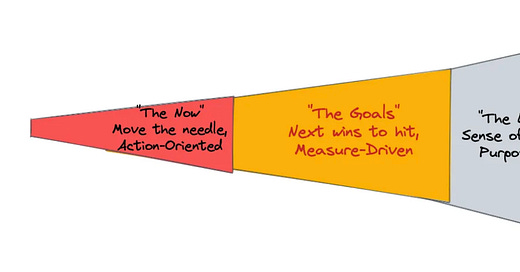Lenses for the three P's (Problems, Plans, Prioritization): Plans (2/3)
In case you missed last week's, this is a three-part series I am doing as I approach a kind of milestone with the first hundred posts with this blog. Here's the first part.
Let's talk about plans. They are nothing. There, I said it. Move on?!
Well, it's true, but also nuanced. And you don't need to take my word on it, but Eisenhower's:
"Plans are nothing; Planning is everything."
This is really more profound than semantics, and it's not the first time I write about it here. It's really the difference of acting on the static (following a set plan) and embracing the dynamic (adapting to circumstances). You can go with the Mike Tyson version of it, if you want:
“Everyone has a plan: until they get punched in the face.”
These are things that go back to rather ancient knowledge on military, for instance. The "Art of Action" by Steven Bungay is a great book to learn more about how that gets embraced and informs modern thinking of (military, and beyond) strategy.
So we there have our first lens: the idea that plans are supposed to be in motion, and that's the insight that Eisenhower's quote elegantly brings about by changing it to a verb in the gerund form. We can get all technical on how to ensure that continuous planning to be driven by data (e.g., by using techniques like Monte Carlo simulations based on past behavior data of our system of delivery), but perhaps a kind of "poor man's version", like the little simulation game I presented here some time back, can do the trick.
Depending on how you are approaching your execution, chances you are missing the opportunity to better manage the underlying risks. For instance, you may be diluting so much of your risk by working in so many things in parallel (so-called "peanut butter tactic"), at the price of things that may matter to you, like shortening feedback loops. As more things are going in parallel, bigger the chance they will take longer to finish, thus feedback will tend to be delayed. And with that, not being able to ensure that the thing that matter most will be the one finished first. Put in other words, it's not priority but things like batch size that might play a bigger role on what is finished first in that context.
That is to say that other useful lens when dealing with issues of planning is precisely to approach it with the mentality of reducing uncertainty (which tags along quite nicely with the previous post insight on managing risks, in fact). To recude uncertainty, it's a good idea to keep focus.
If you can only do one thing, what would that be, now? What will help me to get me closer to hit my next goal(s), which are aligned with my bigger purpose for the long-run?
(Excuse me for the bad sketching skills but hopefully it helps to visualize the funnel of reducing uncertainty that I am alluding to.)
If you stretch that idea a little further, to its natural consequences, the "long haul" is not really a well-defined enough destination, but only a sense of direction (which is "good enough"); it's inspirational. Thus we should only practically think of plans in a twofold time horizon perspective:
What am I now working towards accomplishing (say, for the next foreseeable future like a quarter)? And if you can only do one thing, what would that be, now, that should help me to get closer to that?
That brings me nicely to the last insight and lens for today, the twofold planning horizon:
We inspirationally orient ourselves towards a long-term purpose that drive us;
We figure out that are the proximate goals that are both coherent with that purpose as well as feasible to accomplish next
We translate that into a more tangible (set of) objective(s) we could focus for the horizon of time where things should be sufficiently stable (like a quarter seems to be an often reasonable choice);
We prioritize one or a few (ideally one but definitely not more than a few at a time) to focus on next;
We bring it much closer to rather "humble plans" we can execute now.
At the tactical level, whatever "planning event" we want to do should be oriented towards that selection of what to focus on next, and the what to do now, what truly "makes or breaks" in the end, is the embodiment of the dynamics and the motion of keep adapting as things evolve, as circumstances and context may change. And "adapting", in this context, has a lot to do with prioritizing – story for another day (next week to be precise)...
By Rodrigo Sperb, feel free to connect, I'm happy to engage and interact. If I can be of further utility to you or your organization in getting better at working with product development, I am available for part-time advisory, consulting or contract-based engagements.



